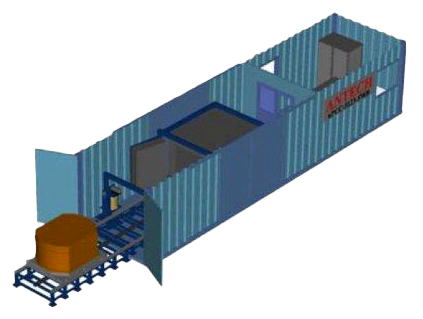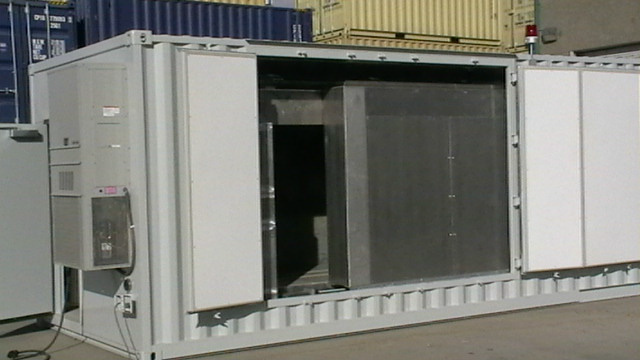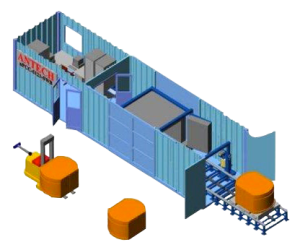The ANTECH N2940-2552 Active-Passive Crate Counter is an enhanced efficiency active/passive neutron counter designed for the measurement of plutonium and uranium in nuclear wastes contained in a variety of crates and waste boxes.
The N2940-2552 can be configured to the customer’s requirements to measure a variety of waste boxes including B25 Box or the Standard Waste Box (SWB). The inner assay chamber walls contain a thick graphite liner that extends the neutron slowing-down time and enhances the thermal neutron interrogating flux.
- Capable of both 'active' operation for the measurement of fissile nuclides combined with a conventional 'passive' mode capability for the measurement of the fertile nuclides, principally ²⁴⁰Pu, giving complete flexibility for the measurement of plutonium and uranium in waste
- Measurement based on the differential die away (DDT or DDA) principle using thermalised neutrons from a D-T generator to create induced fissions in fissile material present in the waste
- System can be confirmed with HPGe gamma-ray based plutonium isotopic ratio measurement station, this provides a complete assay result
- In a non-moderating, non-absorbing (metallic) waste matrix the N2940-2552 is capable of achieving the USA TRU limit of 3700 Bq/g for the measurement of uranium and plutonium
- Long die-away time (>1 ms) and high neutron detection efficiency provide enhanced sensitivity
- System is constructed so that the ³He tubes can be easily replaced, which enables ease of maintenance and enhances reliability
Benefits
- Robust construction avoiding 'high-Z' materials to reduce interfering neutron background
- Measurement chamber lined with graphite to produce a long neutron die away time
- Semi-automatic crate or box loading capability
- Fitted with a Thermo Fisher Scientific (formally MF Physics) neutron generator of proven high reliability
- Typically, 24 fast neutron detector packages (4 in either of the two sides, the top and bottom and the two ends) each containing 4 x ³He tubes (4 atmospheres fill pressure)
- Nuclear counting electronics includes a state of the art multi-channel scaler for active mode operation combined with a Time Correlation Analyser (TCA) for passive mode operation
- Optional High Purity Germanium (HPGe) gamma ray spectrometer for plutonium isotopic ratio determination
Features
-
Description
The Neutron detection system consists of cadmium shielded ³He proportional counters, typically in 4π geometry. The detectors are positioned vertically in each of the four side walls and detectors in the top and bottom of the instrument are positioned horizontally. The detectors in each of the four walls are connected to a high voltage junction box that contains an Amptek charge sensitive amplifier and discriminator circuit and connections for high voltage, low voltage and signal cables.
Polyethylene back shielding is provided to reduce the effects of ambient background. The outer surface of the counter is covered in stainless steel cladding and the graphite liner is clad in aluminium. Additional detector packages are mounted on the interior walls of the chamber cavity to acquire information on the degree of interrogating neutron self-shielding in fissile material. Flux monitors are installed to correct waste matrix bias effects.
The D-T neutron generator (Thermo Fisher Zetatron accelerator) is normally mounted in the roof of the chamber to provide a uniform interrogation of the crate during the assay. In conventional active totals mode pulses of neutrons are used to interrogate a waste drum. A neutron generator is pulsed at 100 Hz producing 14-MeV neutrons, which are slowed down in the graphite layer providing a source of thermal neutrons that cause induced fission of the ²³⁵U and ²³⁹Pu in the waste. Cadmium shielded detector packages are used to measure the prompt fission neutrons (from induced fission) in a time period (~500 µs) when neutrons from the initial generator burst have been cleared from the fast detector packages. Additional ³He flux monitors are placed in the measurement chamber and provide a measure of the interrogating neutron intensity and its die away characteristics. A later time period is used to determine the background due to delayed neutron production from fission products and from any spontaneous fission neutrons present. The fissile mass is proportional to the net fissile signal normalised to the interrogating flux. The system must be calibrated for uranium and plutonium mass using representative matrices.
The passive mode operation uses conventional neutron counting of the correlated neutrons arising from spontaneous fission of the even plutonium nuclides, principally ²⁴⁰Pu. Plant measured isotopic ratios (from high resolution gamma spectrometry) can be used by the software in order to convert ²⁴⁰Pu effective mass to total plutonium mass.
-
Specifications
External Dimensions1628 mm x 2458 mm x 1591 mm
(64.09 in x 96.77 in x 62.64 in) Approximate Height x Width x DepthWeight~ 8000 kg
(1763.70 lb)Die Away Time~ 40 ms Fast Detector PackagesDie Away Time~ 1 - 1.5 ms (chamber)Detection Efficiency5% with empty chamber (approx.)





